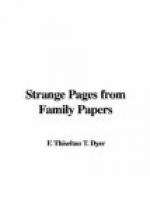Heart! thou didst press forward
still
When the trumpet’s note
rang shrill,
Where the knightly swords
were crossing
And the plumes like sea-foam
tossing.
Leader of the charging spear,
Fiery heart—and
liest thou here?
May this narrow spot inurn
Aught that so could heat and
burn?
The heart of Richard, the Lion-hearted, has had a somewhat eventful history. It seems that this monarch bequeathed his heart to Rouen, as a lasting recognition of the constancy of his Norman subjects. The honour was gratefully acknowledged, and in course of time a beautiful shrine was erected to his memory in the cathedral. But this costly structure did not escape being destroyed in the year 1738 with other Plantagenet memorials. A hundred years afterwards the mutilated effigy of Richard was discovered under the cathedral pavement, and near it the leaden casket that had inclosed his heart, which was replaced. Before long it was taken up again, and removed to the Museum of Antiquities, where it remained until the year 1869, when it found a more fitting resting-place in the choir of the cathedral.
James II. bequeathed his heart to be buried in the Church of the Convent Dames de St. Marie, at Chaillot, whence it was afterwards removed to the chapel of the English Benedictines in the Faubourg St. Jacques. And the heart of Mary Beatrice, his wife, was also bequeathed to the Monastery of Chaillot, in perpetuity, “to be placed in the tribune beside those of her late husband, King James, and the Princess, their daughter.” Dr. Richard Rawlinson, the well known antiquary bequeathed his heart to St. John’s College, Oxford; and Edward, Lord Windsor, of Bradenham, Bucks, who died at Spa in the year 1754, directed that his body should be buried in the “Cathedral church of the noble city of Liege, with a convenient tomb to his memory, but his heart to be enclosed in lead and sent to England, there to be buried in the chapel of Bradenham, under his father’s tomb, in token of a true Englishman.”
Paul Whitehead, who died in the year 1774, left his heart to his friend Lord le Despencer, to be deposited in his mausoleum at West Wycombe. Lord le Despencer accepted the bequest, and on the 16th May, 1775, the heart, after being wrapped in lead and placed in a marble urn, was carried with much ceremony to its resting place. Preceding the bier bearing the urn, “a grenadier marched in full uniform, nine grenadiers two deep, the odd one last; two German flute players, two surpliced choristers with notes pinned to their backs, two more flute players, eleven singing men in surplices, two French horn players, two bassoon players, six fifers, and four drummers with muffled drums. Lord le Despencer, as chief mourner, followed the bier, in his uniform as Colonel of the Bucks Militia, and was succeeded by nine officers of the same corps, two fifers, two drummers, and twenty soldiers with their firelocks reversed. The Dead March in “Saul” was played, the church bell tolled, and cannons were discharged every three and a half minutes.” On arriving at the mausoleum, another hour was spent by the procession in going round and round it, singing funeral dirges, after which the urn containing the heart was carried inside, and placed upon a pedestal bearing the name of Paul Whitehead, and these lines:




